
In the US, tree diameter is usually measured at 4.5 ft (137 cm) above ground level. Measurement at this height is referred to as diameter at breast height or DBH. DBH can be measured with a specially calibrated tape measure called a diameter tape (d-tape) available from arborist or forestry supply dealers. In a tree with a clear gradually tapering trunk, measuring DBH is straightforward, but there are a number of circumstances in which questions arise about how to measure DBH. The following guide can be used to solve some of the more common complications. In the guide below we have generally used the simplest methods we found recommended in other sources. Other guides with illustrations can be found at:
The Tree Register of the British Isles - http://www.tree-register.org/tree-conservation.htm
Canada's National Forest Health Monitoring Plot Network Manual on Plot Establishment and Monitoring (Revised) from the Environment Canada Ecological Monitoring and Assessment Network (EMAN) site - http://www.lib.unb.ca/Texts/Forest/arnews_site/arnews_e/arnews_e.pdf
USDA Forest Service's Forest Inventory and Analysis (FIA) program manual Phase 2 Measurement Field Guide Version 4.0 -(rules for determining DBH heights for forked trees become very complicated in this manual)
| 1. The tree tapers in such a way that the diameter at a point below 4.5 ft is actually smaller than the diameter at 4.5 ft. Measure diameter at the smallest point and record the height at which diameter was measured on the data sheet. |
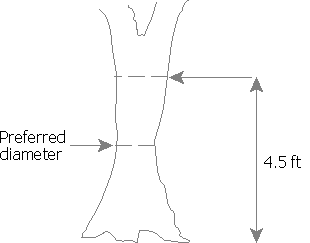
|
| 2. Tree has branches or bumps which interfere with DBH measurement. Measure DBH below the branch or bump. Some references say to measure a foot below the branching point, which assumes this point is the smallest diameter of the trunk below 4.5 ft. US Forest Service measures DBH immediately above point were bumps or branches cease to affect diameter of the stem. The underlying concept is to measure the diameter that would be closest to the expected DBH if branches or other irregularities were not present. Record the height at which the diameter measured. |
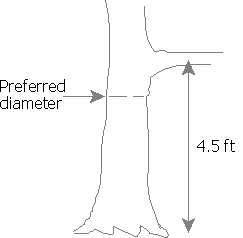
|
| 3. Vertically growing tree is on a slope. There are several commonly accepted ways to find the DBH height. Probably the easiest method is to measure diameter 4.5 ft from the ground on the upper side of the slope. This method is used by the US Forest Service. Some references (e.g., International Society of Arboriculture's Tree Appraisal Manual) say to measure 4.5 ft from the midpoint of the trunk along the slope. However, finding the location of the trunk midpoint is probably subject to more error than finding the upper side of the trunk, so the USFS method is likely to be more repeatable than the ISA method. |
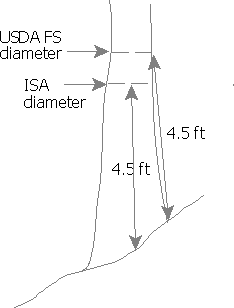
|
| 4. Tree leans. There are several commonly accepted ways to find the DBH height. The US Forest Service measures 4.5 ft up the stem in the direction of the lean. Some references (e.g., ISA) say to measure 4.5 ft from the midpoint of the lean. As noted under 3 above, the USFS method is probably less prone to error and more readily repeatable by different observers. | 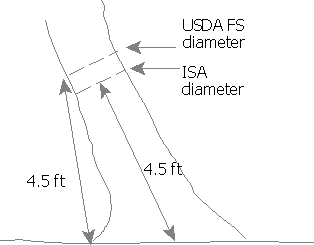
|
| 5. Tree forks below DBH or near DBH. The measurement is recorded at the narrowest part of the main stem below the fork. The height of the DBH measurement and the fork should be noted (e.g., 3 ft diameter @ 2 ft [Forks @ 4 ft]). | 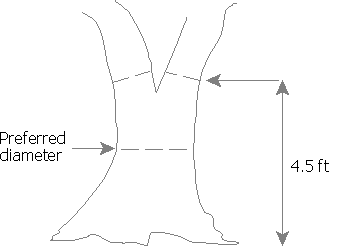 |
| 6. Tree splits into several trunks close to ground level. Measure DBH of each trunk separately, using the principals shown in categories 1-5 above. The DBH for the tree is found by taking the square root of the sum of all squared stem DBHs. |
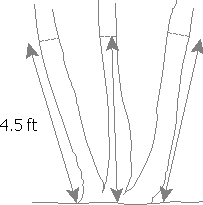
|